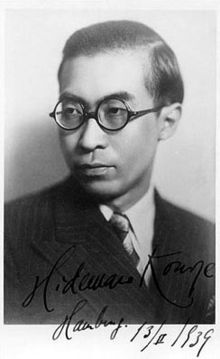Hidemaro Konoye
Hidemaro Konoye | |
|---|---|
| 近衞 秀麿 | |
 Konoye Hidemaro in 1939 signed photo from Hamburg Philharmonic | |
| Born | Hidemaro Konoye 18 November 1898 |
| Died | 2 June 1973 (aged 74) Noge, Setagaya, Tokyo, Japan |
| Alma mater | Tokyo Imperial University, Faculty of Arts dropout |
| Occupation(s) | Conductor, composer, music arranger |
| Years active | 1920–1973 |
| Children | Hidetake Konoe Tadatoshi Miyagawa |
| Parents |
|
| Relatives | Tadamaro Miyagawa (brother) Naomaro Konoye (brother) Fumimaro Konoe (brother) |
Viscount Hidemaro Konoye (近衛 秀麿, Konoe Hidemaro, 18 November 1898 – 2 June 1973) was a Japanese conductor and composer of classical music. He was the younger brother of pre-war Japanese Prime Minister Fumimaro Konoe.
Biography[edit]
Konoye was born in Kōjimachi, Tokyo. He was the younger son of Duke Konoe Atsumaro, scion of one of the Five Regent Houses of the Fujiwara clan. The Konoe clan traditionally provided gagaku musicians to the Imperial Household. Despite this, Konoye pursued music over the objections of his family, who wished for him a career in politics. His decision was supported by his older brother, Fumimaro.[1]
Konoye attended the Gakushuin Peers School, where he became a close friend of Takashi Inukai. In 1913, he entered the Tokyo University of the Arts, where he specialized in the violin. In 1915, he went to Germany briefly to study musical composition. On his return to Japan he became a pupil of Kosaku Yamada.[2] His debut as a conductor was in 1920, with an amateur orchestra led by Tokichi Setoguchi. Konoye returned to Europe for further studies in 1923 in Paris under Vincent d'Indy and Berlin under Franz Schreker.[3] He also studied conducting under Erich Kleiber, and Karl Muck. In 1924, he conducted at the Berlin Philharmonic,[4] and returned to Japan in the fall of the same year.
Konoye co-founded the Japan Symphonic Association in 1925, and the following year became conductor of the orchestra. Konoe later founded the New Symphony Orchestra of Tokyo (the present day NHK Symphony Orchestra), and helped mold the orchestra over a 10-year period into an ensemble that was praised as competitive with many of the better orchestras in Europe.[5]
Today he is remembered for making the première recording of Mahler's Fourth Symphony, done in May 1930. It was also, aside from a cut in the third movement, the first electrical recording of any complete Mahler symphony.[6]

Additionally, Konoye made numerous guest appearances in Europe and America, conducting some 90 different orchestras in the course of his career including the orchestra of La Scala, Milan and the NBC Symphony Orchestra. He created friendships with Erich Kleiber, Leopold Stokowski, Wilhelm Furtwängler and Richard Strauss. He went to Germany and conducted Berlin Philharmonic Orchestra in the second half of the 1930s. In the early days of the NBC Symphony, he planned an American tour under the supervision of Stokowski, but the project was cancelled due to World War II.[7]
In 1964 he performed Mozart's Clarinet Concerto with Benny Goodman.[citation needed]
Japanese premieres[edit]
Konoye conducted many notable Japanese premieres including:[citation needed]
- Richard Strauss: Serenade for Winds (1926)
- Paul Hindemith: Overture to Neues vom Tage (1927)
- Wolfgang Amadeus Mozart: Sinfonia Concertante for Four Winds (1927)
- Kurt Weill: Kleine Dreigroschenmusik (1929)
- Maurice Ravel: Ma mère l'Oye (1929)
- Richard Strauss: Oboe Concerto (with Otto Winter; 1962)
- Darius Milhaud: Oboe Concerto (with Heinz Holliger; 1970)
Composer and arranger[edit]
Konoye wrote original compositions, but was more deeply interested in arranging existing music, including, for example, Modest Mussorgsky's Pictures at an Exhibition and Schubert's String Quintet, which he orchestrated.[8]
Major works[edit]
- Kronungs-Kantate for soprano, mezzo-soprano, baritone, chorus and orchestra (1928)
- Etenraku for orchestra (1931; arrangement of the gagaku piece of the same title)
- Kimigayo (national anthem of Japan) for orchestra
- Chin Chin Chidori for voice and piano
Notable recordings[edit]
- Mahler: Symphony No. 4 (Sakaye Kitasaya (soprano), New Symphony Orchestra of Tokyo; recorded by Japanese Parlophone in May 1930)[6]
Ancestry[edit]
| Ancestors of Hidemaro Konoye | |||||||||||||||||||||||||||||||||||||||||||||||||||||||||||||||||||||||||||||||||||||||||||||||||||||||||||||||||||||||||||||||||||||||||||||||||||||||||||||||||||||||||||||||||||||||||||||||||||||||||||||||||||||||||||||||||||||||||||||||||||||||||||||||||||||||||||||||||||||||||||||||||||||||||||||||||||||||||||||||||||||||||||||||||||||||||||||||||||||||||||||||||||||||||||||||||||||||||||||||||||||||||||||||||||||||||||||||||||||||||||||||||||||||||||||||||||
|---|---|---|---|---|---|---|---|---|---|---|---|---|---|---|---|---|---|---|---|---|---|---|---|---|---|---|---|---|---|---|---|---|---|---|---|---|---|---|---|---|---|---|---|---|---|---|---|---|---|---|---|---|---|---|---|---|---|---|---|---|---|---|---|---|---|---|---|---|---|---|---|---|---|---|---|---|---|---|---|---|---|---|---|---|---|---|---|---|---|---|---|---|---|---|---|---|---|---|---|---|---|---|---|---|---|---|---|---|---|---|---|---|---|---|---|---|---|---|---|---|---|---|---|---|---|---|---|---|---|---|---|---|---|---|---|---|---|---|---|---|---|---|---|---|---|---|---|---|---|---|---|---|---|---|---|---|---|---|---|---|---|---|---|---|---|---|---|---|---|---|---|---|---|---|---|---|---|---|---|---|---|---|---|---|---|---|---|---|---|---|---|---|---|---|---|---|---|---|---|---|---|---|---|---|---|---|---|---|---|---|---|---|---|---|---|---|---|---|---|---|---|---|---|---|---|---|---|---|---|---|---|---|---|---|---|---|---|---|---|---|---|---|---|---|---|---|---|---|---|---|---|---|---|---|---|---|---|---|---|---|---|---|---|---|---|---|---|---|---|---|---|---|---|---|---|---|---|---|---|---|---|---|---|---|---|---|---|---|---|---|---|---|---|---|---|---|---|---|---|---|---|---|---|---|---|---|---|---|---|---|---|---|---|---|---|---|---|---|---|---|---|---|---|---|---|---|---|---|---|---|---|---|---|---|---|---|---|---|---|---|---|---|---|---|---|---|---|---|---|---|---|---|---|---|---|---|---|---|---|---|---|---|---|---|---|---|---|---|---|---|---|---|---|---|---|---|---|---|---|---|---|---|---|---|---|---|---|---|---|---|---|---|---|---|---|---|---|---|---|---|---|---|---|---|---|---|---|---|---|---|---|---|---|---|---|---|---|---|---|---|---|---|---|---|---|---|---|---|---|---|---|---|---|---|---|---|---|---|---|---|---|---|---|---|---|---|---|---|---|---|---|---|---|---|---|---|---|---|---|---|---|---|---|---|---|---|---|
| |||||||||||||||||||||||||||||||||||||||||||||||||||||||||||||||||||||||||||||||||||||||||||||||||||||||||||||||||||||||||||||||||||||||||||||||||||||||||||||||||||||||||||||||||||||||||||||||||||||||||||||||||||||||||||||||||||||||||||||||||||||||||||||||||||||||||||||||||||||||||||||||||||||||||||||||||||||||||||||||||||||||||||||||||||||||||||||||||||||||||||||||||||||||||||||||||||||||||||||||||||||||||||||||||||||||||||||||||||||||||||||||||||||||||||||||||||
References[edit]
- ^ "'Amity Thru Music,' Says Noted Leader". Rafu Shimpo. 24 September 1939. p. 6. Retrieved 14 November 2021.
Admitting that he had to overcome some family opposition when he decided to forsake the traditional career in statesmanship for music, the Viscount declared that the support of his brother, Prince Fumimaro, now head of the Japanese Cabinet, was of inestimable value.
- ^ http://web02.hnh.com/composer/btm.asp?fullname=Konoye,%20Hidemaro[permanent dead link]
- ^ Lebrecht, Norman (1992). The Companion to 20th-Century Music. New York: Simon and Schuster. p. 188. ISBN 0-306-80734-3.
- ^ Morreau, Annette (2002). Emanuel Feuermann. Yale University Press. p. 80. ISBN 0-300-09684-4.
- ^ 樂評人 David Hall 在他的權威著作 "The record book : a music lover's guide to the world of the phonograph" ( 1943年版), 曾經對近衛秀磨這一款錄音有以下之評語:
- ^ a b Smoley, Lewis M. (1996). Gustav Mahler's Symphonies: critical commentary on recordings since 1986 (first ed.). Westport, CT: Greenwood Press. p. 93. ISBN 0-313-29771-1.
- ^ http://homepage2.nifty.com/stokowski/konoye/index.html[permanent dead link]
- ^ Katayarna, Morihide. Japanese Orchestral Favourites (Media notes). Translated by Obstuka, Yuriko. Naxos Records. 8.555071.
External links[edit]
| International | |
|---|---|
| National | |
| Academics | |
| Artists | |
| People | |
| Other | |


 French
French Deutsch
Deutsch